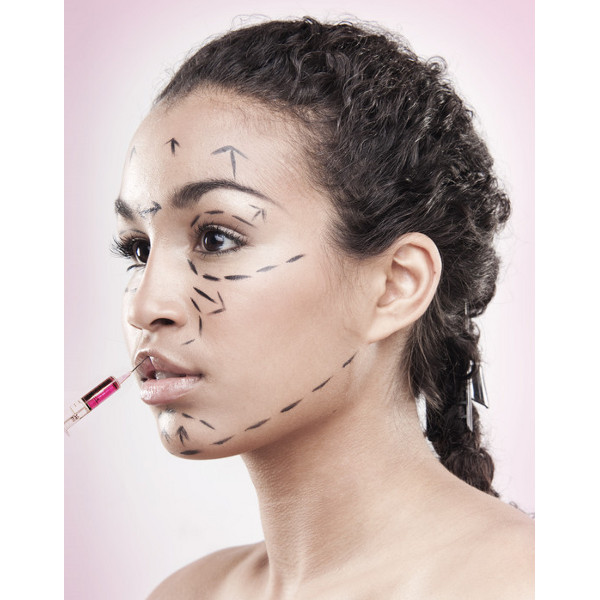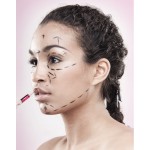
(image via Canstock)
In the second season of Fox’s The Swan, a salacious reality show/beauty pageant, circa 2004, that put all of its contestants under the knife, we meet one of the show’s few African-American contestants. Like the other beauty queen hopefuls, she is nervous — but she’s also conflicted. She drops those two words that encapsulate much of the fears that people of African descent have when it comes to cosmetic surgery — Michael Jackson.
For many African-Americans the heavily modified visage of Michael Jackson is a testament to what great self-hatred can do even the most powerful and talented among our ranks. Perhaps Lil’ Kim would be a better symbol for us Millennials?
Despite the reservations and fears of some, ethnic plastic surgery is on the rise, with people of color accounting for approximately 22% of all procedures, the overwhelming majority of them being women. The number of African-Americans receiving cosmetic procedures has increased over 129% since 2000 — and most of them aren’t going under the knife to achieve ski-slope noses and bigger eyes. According to research compiled by Sunishka Wimalawansa, M.D., Aisha McKnight, M.D.,and Jamal M. Bullocks, M.D. in “Socioeconomic Impact of Ethnic Cosmetic Surgery: Trends and Potential Financial Impact the African American, Asian American, Latin American, and Middle Eastern Communities Have on Cosmetic Surgery”,
Historically, cosmetic surgery has not been as widely accepted in ethnic populations. This is mainly because in the past, many ethnic individuals believed that cosmetic surgery equaled sacrificing aspects of their ethnicity. However, for minorities, cosmetic surgery is no longer viewed as a sign of self-hatred or a rejection of racial identity. In fact, the goal of many ethnic women has shifted and is now to enhance their natural ethnic beauty. Non-Caucasian patients presenting for cosmetic surgery tend to have similar motivations and desires as those of their Caucasian counterparts, such as diminishing the appearance of aging, improving body contour and definition, enhancing symmetry, and modifying tissue volume. In fact, many of the commonly requested procedures do not vary significantly with race (i.e., liposuction, breast reduction, Botox, and injectable fillers). However, procedures involving the nasal and periorbital areas are more ethnically sensitive in nature. Therefore, techniques used for these structures should improve aesthetic appearance without distorting ethnic identity.
Essentially, the goal of the ethnic plastic surgeon is to create a more enhanced version of you, not a whiter you. Ethnic plastic surgeons work to achieve a look for their patients that is the result of careful consideration and study. But, as we’ve discussed in the past, beauty standards are politicized and can careen down a slippery slope pretty quickly. When a writer for New York Magazine recently visited some notable ethnic plastic surgeons in New York City, most of them being people of color themselves, she kept noticing how words like “Caucasian features” would creep in as they explained their craft. In the same piece, we meet Dr. Ferdinand Ofodile, a doctor from Nigeria, who practices in New York and specializes in “ethnic rhinoplasty” for people of African descent.
A different kind of scar treatment brought Dr. Ferdinand Ofodile to plastic surgery. When Ofodile moved to the U.S. from Nigeria in the 1960s to study medicine, he planned to become a vascular surgeon. But a visit home during the Nigerian Civil War convinced him to pursue treatment for those deformed by traumatic injuries, congenital defects, and burns severe enough to impede locomotion, as when scar tissue fuses arms to the torso. Eventually, he returned to the U.S. and became Harlem Hospital’s chief of plastic surgery—and an expert on African-American noses. He spent the early ’90s measuring the noses of Harlem Hospital patients, employees, and grad students (and a few cadavers) and discovering that African-American nasal anatomy was more diverse than previously thought. Fewer than half were the shape “formerly called the Negroid nose,” featuring a low or concave bridge and bulbous tip. Ofodile’s signature “ethnic rhinoplasty” involves the insertion of a hard silicone implant. He has a trademarked design called the Ofodile nasal implant, an undulating arc of silicone “suited to satisfy Hispanic and African-American patient needs.”
Doctors like Ofodile take the unique facial features of their patients into consideration when looking at them as individuals with individual wants and needs. When discussing cosmetic surgery and body modification for people of color, it’s important to not fall into a singular narrative of self-hatred. Empathy is also important, as beauty standards impact women of color in a very unique and complicated myriad of ways. There are many motivations to go under the knife, many stories, many women and many results.

